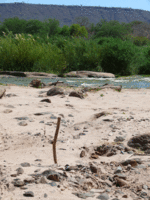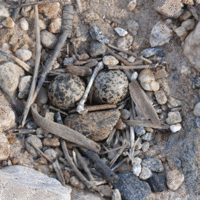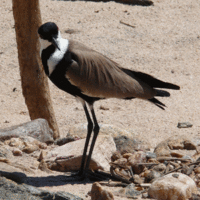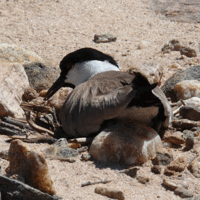29th October 2007
 Tuesday, November 20, 2007 at 08:27PM
Tuesday, November 20, 2007 at 08:27PM This morning could not have been more of a contrast to yesterday. We woke up to a bright, bright sun and a cloudless sky. Where has all the rain gone? Within minutes of the sun clearing the Yatta Plateau to the east, it has been sweltering hot. The Impala were back out on the sandbank, the Striped Swallows looked gorgeous against an azure blue sky, and two Monitor Lizards passed each other without incident down at the river’s edge; the Vervet Monkeys passed through our house, helping themselves to an orange from the fruit bowl and leaving a mess on the floor – we’ll need to keep the fruit out of sight and reach from now on, otherwise the monkeys will become a real problem - and guess what? We had our first bird at the birdbath! It was a Village (aka Black Headed) Weaver, and I caught him on camera. What a momentous three days we’ve had: the day before yesterday, it rained properly for the first time; yesterday, we were connected to the internet; and today, our birdbath finally attracted some birds! First there was one, and within a couple of hours there were many – it just takes one to brave it, then the others soon follow. Later, there was a Grey Headed Sparrow there too. I’m so delighted! The birds have really started making our home into their home, which is so wonderful – it’s beginning to feel like the house really belongs here, and is just an extension of the natural environment. The Weavers have been up on the balcony, taking grass from our flowerbeds for their nests, and also hunting for post-rain insects. They’ve also been busily foraging in the grass jungle at the base of our little baobab tree by the front door.
The geckos have moved in too – small nocturnal lizards that eat mosquitoes and other insects – come one, come all, is what I say – especially if you’re a mosquito-eater! Of course the constant threat of malaria is something we have to contend with here, and we always keep a dose of medication with us at home, and travel with one whenever we are away. We use a herbal based medicine from China which seems to work well without having the harsh side-effects of some medications which cure your malaria, but damage your liver.
There is still a lot of crocodile activity in the river, which has been going on for 3-4 weeks now, with crocodiles constantly drifting downstream on the current, then swimming back up again, and a lot of thrashing around in the reeds at the far side of the river. Are they fighting or mating or fishing? It’s difficult to know. A couple of weeks back we watched a large crocodile drift the full length of our balcony view – that’s about two kilometres – before he drifted out of sight round the corner of the river. Did he have a plan in mind and know where he was going, or was he just drifting non-specifically?
I am sure the Green Backed Herons must be nesting for we hardly see them on the sandbank below the house these days, where a couple of weeks ago there were always one or two, combing the river edge for prey, hunched up and statue-still, resembling a bittern more than a heron. Instead, they’re now always flapping around in the reeds on the other side of the river, flying backwards and forwards and making a lot of noise. I may well be wrong, but my guess is they have a nest in the reeds somewhere.
As I suspected when I saw them fighting and collecting grass yesterday, the African Golden Weavers (which we saw coming for bird food for the first time yesterday, though we’ve been watching them on the reed islands for a while) have completed a nest in the reeds in the middle of the river – and there may well be more nests on the other side of the island, which we can’t see. The Black Headed (aka Village) Weavers were also busy stripping the reeds for their nests in the baobab up behind our house.
It’s amazing how quickly the bushland is transforming – even just those few damp days have brought the commiphora and delonix trees out in leaf. Let’s hope we get some more rain so the trees’ efforts are not all in vain.
I am working from my new office for the first time today, which is on the ground floor of our house. Although Kulafumbi is an entirely privately owned and built house, we are setting out to run the Film Foundation from here - the use of the downstairs as an office is a personal contribution given to the Foundation by my father.
I’ve had to position my desk back from the window and the river view, otherwise I wouldn’t ever get any work done – there’s always something going on outside to watch, and it’s difficult to tear yourself away. That’s the problem with keeping this journal too – it’s easy to become obsessive about it. Every day, there are so many changes happening and though they may be subtle or seem insignificant, they all are important – today the trees are budding, today a new flower emerged, today the birds started nesting – so many minor yet major changes, and I want to record them all!
My flower book is making me more frustrated than ever – with the rain of the last few days, many plants are flowering and I have no means of identifying them. I’m photographing them nonetheless and will attempt to find out later what they are – like the pretty pale yellow flower with a peachy orange-red centre, which has appeared today in the grass to the left of the house, by the far guest bedroom.
The Spur-winged Plovers have a nest on the sandy riverbank near the place my father collected the rocks, which were used for building our house, and where he’s currently collecting rocks to build the houses for the resident Film Foundation staff. The speckled beige and black-ink-smudged eggs are laid on the ground, in a nest fashioned from twigs and small stones – which the plover continues to re-arrange while sitting on the nest and protecting the eggs from the boiling sun. It’s amazing how camouflaged the nest is, even with the adult bird sitting on it. My father had to put a stake in the ground right next to the nest, to ensure he doesn’t drive over it in the tractor by mistake, but if it were not for that, you would have a hard time spotting where the nest is. No wonder the plovers on the sandbank right by our house were able to raise a family right under our noses, without one of us even noticing.
We went down to watch the hippos this evening – becoming ever more crowded in their deep pool at the end of the sandbank. It’s hard to count how many there are, as they keep popping their heads up and down and different times, so you can only ever see half the hippos at any one time, but it certainly seems to me there are more than 18 congregated there now. As for me, I must have looked a bit odd, wedged in under an old log in the sand, which I was using to hold the long lens steady…oh well, it’s all fun…
Follow the entire Plover Story in pictures...










Reader Comments